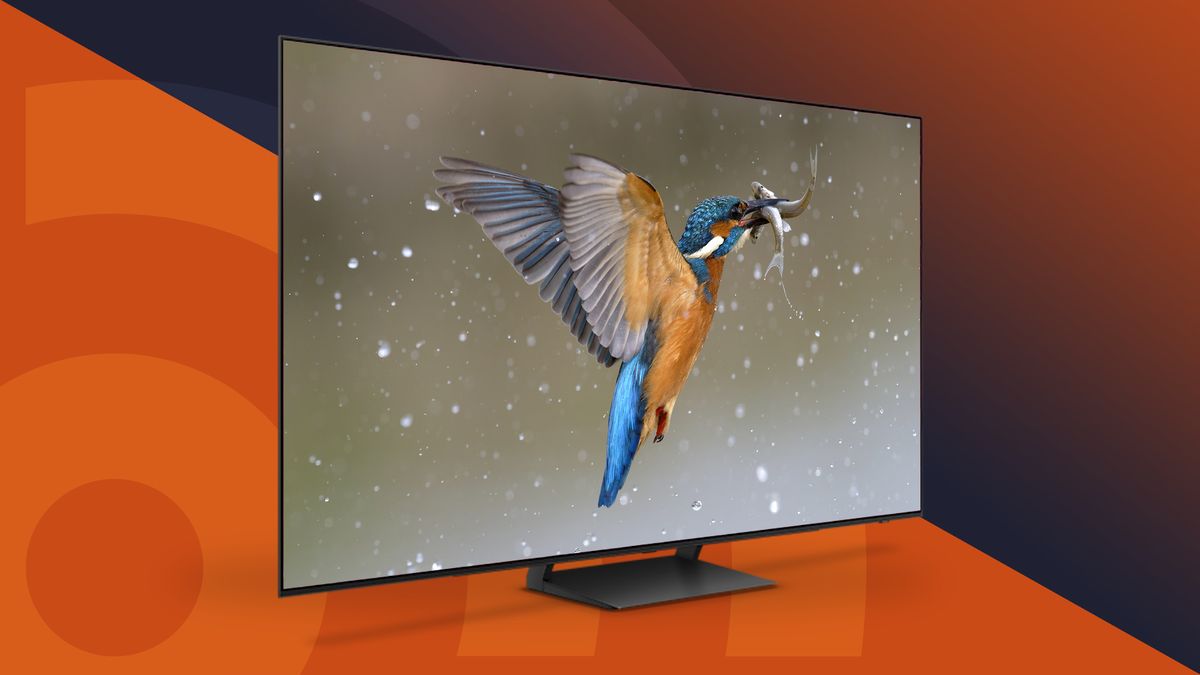
The best TV 2024, chosen by our reviewers for all budgets
It isn’t easy to find the best TV – there are so many options with elaborate screen tech and jargon-filled features – but the good news is that an excellent home theater experience has never been more affordable.
This guide will help you find the best TV in your budget range, based on our extensive testing experience with these sets. We’ll cut the overwhelming number of options down to just the most worthwhile, from cheap options to cutting-edge flagship sets. To make our choices, we’re balancing picture quality, features, sound quality, price, and size options. If you’re looking for something specific, you might prefer to head straight to our guides to the best gaming TVs, best TVs under $1000 or best OLED TVs – but here, you can get an overview of everything.
We’re confident you’ll find the best TV for you in this list – if you don’t see a model you have in mind here, bear in mind we may still have tested it, it’s just that we think the TVs in this guide offer better value.
The quick list
Want the simplest guide to the best TVs around? Here’s our quick guide – you can read more in-depth verdicts on each TV by following the link, as well as alternative options in some cases.
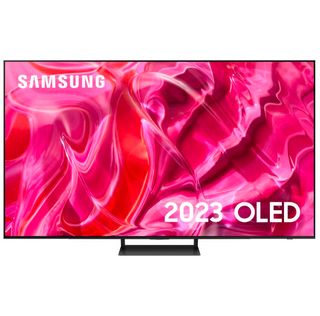
The best TV for most people
The Samsung S90C does it all. Excellent picture, top-tier gaming performance, great built-in sound, and provides a more budget way into the world of QD-OLED.
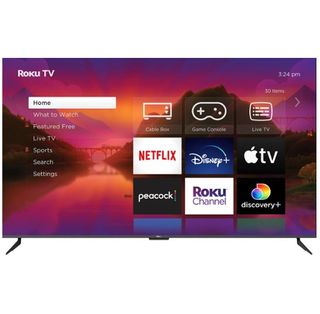
The best budget TV
A QLED display with full-array local dimming, Dolby Vision and HDR10+ support, easy to use smart software, and a seriously affordable price tag; it’s a winner.

The best mid-range TV
A flagship mini-LED TV that sells for a mid-range price, the TCL QM851G combines high brightness with powerful local dimming and an anti-reflection screen.
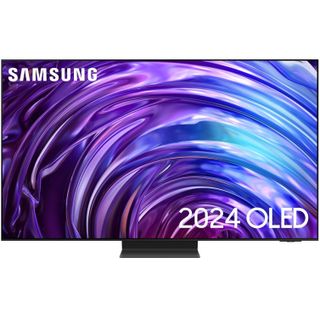
The best premium OLED TV
With superb brightness levels thanks to QD-OLED technology, and a new anti-reflection screen tech, the Samsung S95D is the best OLED TV you can buy.
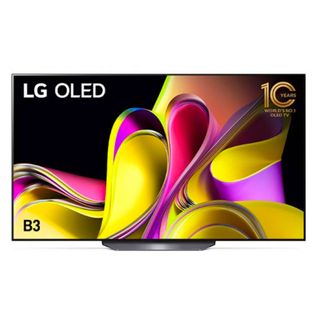
The best cheap OLED TV
The LG B3 is LG’s entry-level OLED TV from 2023 and provides stunning picture quality and gaming features that equals much more premium models.
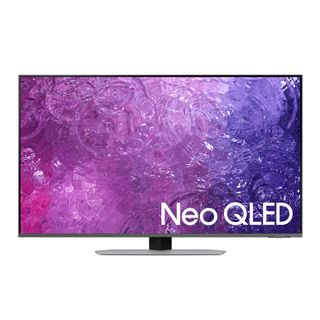
The best bright TV for daytime sport
This hits far higher brightness levels for watching on bright days than most similarly priced sets, and handles motion well – and is ideal for gaming.
Load the next products…
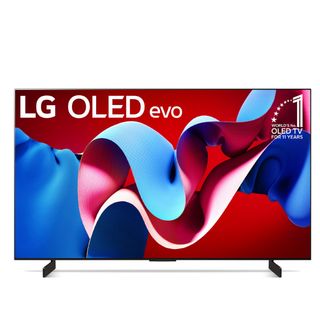
The best for versatility
Gaming, picture quality, an intuitive smart TV platform, and a wealth of sizes from a smaller 42-inch to a large 83-inch; the LG C4 covers all the bases in a way that few TVs do.
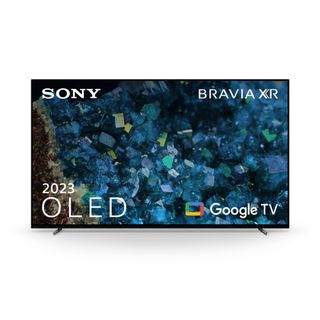
The best TV for sound
Sony uses the whole screen as a speaker to make this mid-range OLED sound a cut above the likes of the LG C3 or Hisense U8K. It looks great, too.

Al Griffin
I’ve been working in AV product testing and tech journalism for nearly 30 years, and I’ve had my eyes on basically every flagship TV available today. Before joining TechRadar, I was editor of Sound & Vision magazine. I shaped this list with the help of our reviewers on top of my own experience, to cover as many bases as possible for different budget or viewing needs.
April 12 2024
Added a new ‘More TVs to consider section’, covering other models not in the list, and explaining why they missed the cut.
The best TV 2024
Why you can trust TechRadar
We spend hours testing every product or service we review, so you can be sure you’re buying the best. Find out more about how we test.
Below you’ll find full write-ups for each of the best TVs in our list. We’ve tested each one extensively, so you can be sure that our recommendations can be trusted.
The best TV for most people
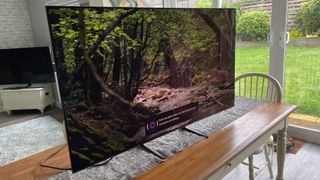
BUY IT IF
✅ You want QD-OLED for relatively cheap: The Samsung S90C gives you a brighter OLED screen than the LG C3, and fantastic picture quality, for the same price as C3.
✅ You need lots of HDMI 2.1 ports: HDMI 2.1 is available on all four of the S90C’s HDMI ports, supporting 4K 120Hz for unbeaten connectivity.
DON’T BUY IT IF
❌ You want the brightest OLED available: Both the Samsung S95C and the LG G3 offer higher brightness levels than the S90C.
❌ You want an 80-inch TV: The 83-inch model uses a different screen type that’s far less bright – we wouldn’t recommend it. Get the 83-inch LG C3 instead, which has Dolby Vision.
The Samsung S90C takes the top spot on our best TV list because it does it all; excellent picture quality, sleek design, brilliant gaming performance and it gives you access to QD-OLED technology for the cheapest it’s ever been. With prices dropping over time too, this gives you real OLED bang for your buck.
With excellent contrast levels, dynamic and punchy colors and deep, rich blacks that we come to expect from an OLED, we found in our review that the S90C’s extra brightness compared to the LG C3 (further down this list) or Sony A80L really adds an extra layer, despite these TVs all costing the same. Its sharpness levels and detail are also a sight to behold. One thing to note, though, is that the 83-inch model uses a regular OLED screen that’s much less bright, and we would recommend getting the 83-inch LG C3 instead.
Not just a beautiful TV, the Samsung S90C is also a gamers’ paradise. With a refresh rate of 144Hz, it has four 2.1 HDMI ports that all support ALLM and VRR as well as 4K 120Hz. It also has a gaming hub so you can tweak setting easily to get the most out of your games. Add to this built-in sound quality that beats almost all other TVs, including LG’s OLEDs, you get a complete package with the S90C.
It’s not totally perfect (the lack of Dolby Vision support is a shame), and higher-priced OLEDs such as the Samsung S95C (at #4 in this list) and LG G3 can beat it for brightness. But in terms of what you get at this budget level, the Samsung S90C is real value for money and is the best TV for most people.
Read the full Samsung S90C review
The best budget TV
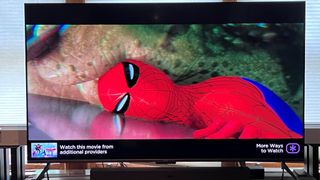
BUY IT IF
✅ You want a great smart TV interface: Easy navigation and a large app selection make Roku TV one of the best smart TV software options around.
✅ You want a great-value TV: The Roku Plus Series offers strong picture quality and an intuitive smart TV interface at a very affordable price.
DON’T BUY IT IF
❌ You don’t want to use a soundbar: The Roku Plus Series has less impressive built-in sound and could definitely benefit from a soundbar.
❌ You’re watching in a bright room: With average brightness levels, the Roku Plus Series will struggle in brighter viewing environments.
The Roku Plus Series is a budget TV that provides very good overall picture quality that exceeds its price tag. Coupled with a great smart TV interface, the Roku Plus Series is a real option for people looking for a new TV on a tight budget.
Picture quality is the real highlight of the Roku Plus Series. Colors are vibrant and have a real visual punch. Motion is also processed well, with fast panning shots not suffering from much blurring that a lot of budget TVs tend to and images look crisp and clean. However, picture suffers a little when viewed from off center, and the Roku Plus Series has average brightness levels, so isn’t the best for brighter viewing environments, but it’s hard to argue against the quality of picture you get with the Roku Plus for the money you pay.
The Roku TV smart TV platform built in to the TV is one of the better smart TV interfaces. It’s easy to navigate and comes with a wealth of app options and even offers the Roku Live TV portal that enables access to a load of free channels. It’s worth noting that accessing picture settings within the Roku Plus Series can be a real pain, but Roku TV still sits as one of the best smart TV platform.
The Roku Plus however is not the best for gaming, with no 120Hz support or cloud-based gaming options, and its built-in audio isn’t the best so a soundbar may be required – but for the money, this is a great-looking TV with good features and a top-tier smart TV platform.
Read the full Roku Plus Series review
The best mid-range TV

BUY IT IF
✅ You want a great TV for sports: The super-bright picture is perfect for daytime viewing and is helped by an anti-reflection screen.
✅ You want a great TV for movies: The bright picture brings out highlight detail in 4K movies with HDR and the powerful local dimming helps immensely with contrast and shadows.
DON’T BUY IT IF
❌ You plan to watch with a crowd: The QM851G doesn’t look as good from far off-center seats as it does on-axis, so viewers in the middle seats experience the best picture.
❌ You plan to watch in a dark room: While the TCL provides great all-around performance, its more-than-ample light output makes it a better match for brighter viewing rooms.
The TCL QM851G is a flagship TV from the company that sells at a mid-range price. Its exceptionally bright picture is balanced by impressive contrast and shadow detail – something made possible by a mini-LED backlight with powerful local dimming. An anti-reflection screen makes the QM851G particularly good for daytime sports, but it’s also a versatile performer that works equally well for movies and TV.
Google TV is used as the TCL QM851G’s smart TV platform, and it also supports both AirPlay 2 and Chromecast built-in for wireless streaming. A built-in mic allows for hands-free voice commands and TCL’s “Fullview 360 Metal Bezel-less” design gives the TV a premium look.
Along with sports and movies, the QM851G performs well for gaming and features two HDMI 2.1 ports with support for 4K 120Hz plus FreeSync Premium Pro and 144Hz VRR. A game bar menu allows for quick onscreen adjustments to gaming picture modes, and it also has settings for shadow enhancement, aiming aid, and other gaming-related features.
Available in screen sizes ranging from 65 to 98 inches, the QM851G was reasonably priced when first released, but subsequent price drops have made it an even better value. If you’re looking for a big-screen TV that does most everything well at a mid-range price, TCL’s top mini-LED model is hard to beat.
Read our full TCL QM851G review
Best premium OLED
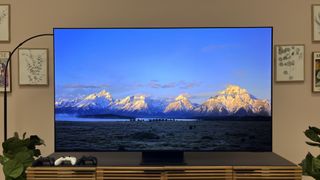
BUY IT IF
✅ You want OLED picture but also brightness: The S95D offers best-ever brightness and detail thanks to a QD-OLED panel and AI picture enhancements.
✅ You want an OLED TV for bright rooms: New OLED Glare Free tech in the S95D is highly effective at eliminating screen glare in bright viewing environments.
DON’T BUY IT IF
❌ You want the brightest picture possible: Although the S95D is very bright for an OLED TV and has new glare-free tech, mini-LED TVs generally deliver even better brightness.
❌ Dolby Vision is a must: Samsung’s TVs continue to lack Dolby Vision HDR support and the S95D is no exception.
The Samsung S95D is the successor to the Samsung S95C, a TV that took OLED brightness to a new plateau for the technology. Like the S95C, the S95D combines an OLED display panel with quantum dots for enhanced color, but Samsung’s new model is even brighter, hitting a peak of nearly 1,700 nits, the same brightness level as mini-LED TVs.
New AI-driven technologies in the Samsung S95D work to bring out incredible levels of detail in both 4K and regular HD sources. Colors look bold, yet natural, and dark images show a high level of shadow detail. A new feature Samsung introduced with the S95D is an “OLED Glare Free” anti-reflection tech that effectively eliminates screen glare even when viewing in bright room lighting conditions, a long-standing challenge for OLED TVs.
While movies and TV look fantastic on the S95D, it’s also a powerful gaming TV with 144Hz refresh rate and VRR with FreeSync Premium Pro support on all four HDMI 2.1 ports. Other gaming features include Samsung’s Game Bar onscreen menu and Samsung Gaming Hub, which lets you play cloud-based games from Xbox, Nvidia GeForce Now, Luna, Utomik, and more.
From a design perspective, the Samsung S95D looks great with its super-slim profile, thin bezel, and unique stand that makes the TV appear to be floating on air.
It also comes with Samsung’s battery-free SolarCell remote control and uses an external One Connect Box for source connections that helps with wall-mount installations.
Read the full Samsung S95D review
Best cheap OLED TV
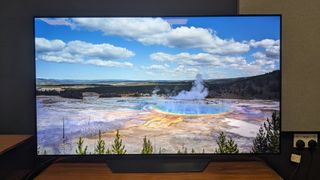
BUY IT IF
✅ You want excellent OLED pictures: With deep blacks and punchy colors, the LG B3 has an outstanding picture despite being LGs’ entry-level 2023 OLED.
✅ You want excellent gaming performance: The LG B3 offers 4K 120Hz support, Dolby Vision gaming and VRR and ALLM connectivity and a handy Game Optimizer mode.
DON’T BUY IT IF
❌ You need more than two HDMI 2.1 ports: Despite excellent gaming performance and features, the LG B3 only offers this one two of its four ports.
❌ You need the best built-in sound: While it’s respectable, the B3’s sound system is definitely not as punchy as other TVs available, like the Samsung S90C (#1 on our list).
With its prices finally dropping, the LG B3 now offers an entry-level option to 2023 OLEDs but doesn’t compromise on picture quality or gaming performance. Its features rival plenty of other OLEDs on the market, and you don’t have to fork out as much to get sumptuous image quality.
Superb contrast levels with deep blacks and dynamic colors combine to give the B3 a picture that feels more premium than the price tag it comes with. It offers Dolby Vision HDR support and when used, movies and TV shows look fantastic with it. It doesn’t have high brightness levels however, with the LG C3, Samsung S90C and even the Sony A80L beating it. It still handles reflections well despite this in reasonable controlled environments, but for bright room viewing, such as sports during the day, something like the Samsung QN90C (#7 in this list) will be much more visible.
With LGs’ Game Optimizer feature included, the LG B3 is a real dark horse for gaming. The ability to tweak so many settings while playing really means you can tailor your gaming experience to whatever game you’re playing. It also has 4K 120Hz, VRR, ALLM and Dolby Vision gaming support. It’s a little disappointing that this is only on two of its four ports, but that’s okay for the more casual among us.
The B3 does have a distinctly average built-in sound system, though, and its stand doesn’t feel the right quality when compared to its price tag, but there is still plenty on offer here to make the LG B3 a real consideration if you’re looking to upgrade your TV and make your way into the world of OLED.
Read our full LG B3 review
The best TV for sport
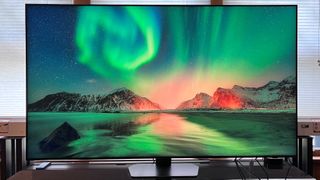
BUY IT IF
✅ You want a perfect TV for daytime viewing: With high brightness and anti-glare screen, the QN90C is perfect for those with bright rooms.
✅ You want a great gaming TV: With four 2.1 HDMI ports that support 4K 120Hz, VRR and FreeSync and an intuitive cloud based gaming platform.
DON’T BUY IT IF
❌ You want the best TV, money no object: The QN90C offers impressive performance, but the QN900C offers better shadow detail, brightness and black depth.
❌ Your budget is limited: You can get a decent mini-LED TV for less in the form of the Hisense U8K at #3 on this list, although it doesn’t offer quite the QN90C’s performance.
Samsung’s QN90C series TVs feature a mini-LED backlight, which not only gives higher brightness than LED or QLED panels, but more accurate local dimming as well. And while the QN90C doesn’t quite hit the OLED-like heights of the company’s flagship QN95C when it comes to rendering the deepest shadows, its performance on that front is nonetheless impressive. Along with its strong brightness, the QN90C’s anti-glare screen it a brilliant TV for viewing daytime sports.
Gaming is a particularly strong point for Samsung Neo QLED TVs, and the QN90C has four HDMI 2.1 ports, with 4K 120Hz capabilities. There’s also the Samsung Game Hub which offers cloud-based gaming from the likes of Utomik, Amazon Luna and even Xbox.
The QN90C has better than average audio performance for a TV, including an Object Tracking Sound Plus feature to enhance the directionality of effects in movie soundtracks. It also supports the company’s Q-Symphony feature, which lets you pair the TV with select Samsung soundbars for a more spacious and dynamic audio experience.
There are cheaper mini-LED alternatives from brands such as Hisense and TCL, but they won’t give you the same picture quality or features that the Samsung QN90C can offer.
Read our full Samsung QN90C review
The best TV for versatility
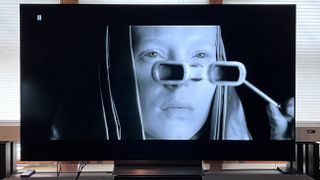
BUY IT IF
✅ You like a wide choice of sizes: Ranging from 42-inch to 83-inch, the LG C4 can fit anywhere in the house, from desk to home theater.
✅ You want a TV for movies and gaming: The LG C4 has very strong picture quality, and gaming features to cover every avenue.
DON’T BUY IT IF
❌ You want the brightest OLED available: The Samsung S95D (#4 in the guide) offers higher brightness than the LG C4, though the C4’s boosted brightness over last year’s C3 model puts it on par with the Samsung S90C (#1 in the guide).
❌ You have the LG C3: While the LG C4 has a brighter picture than last year’s C3, its features are largely the same and the brightness boost isn’t dramatic enough to warrant an upgrade.
The LG C4 is a great all-around choice for movies, gaming, or general TV viewing. Its wide range of screen sizes – models start at 42 inches and span up to 83 inches – also means a C4 can be used in any application, from a bedroom or desktop gaming TV to a big-screen set for a home theater.
LG’s C4 gets a brightness boost over its predecessor, the LG C3, and its brighter picture and anti-reflection screen make it a fine option for daytime viewing. It supports the Dolby Vision, HDR10, and HLG high dynamic range formats, and also has a new Dolby Vision Filmmaker Mode picture preset that lets you watch movies the way the director intended without having to adjust picture settings.
LG’s new Alpha 9 AI Processor Gen7 improves the audio quality of the TV’s built-in 2.2-channel speakers by using AI to upmix to a virtual 9.1.2-channel Dolby Atmos format, and there are proprietary features that let the TV work with LG soundbars for even more immersive sound. The LG C4 is also stocked with gaming features including four HDMI 2.1 ports with 4K 120Hz, VRR, and ALLM support, and 144Hz certification from Nvidia.
Other OLED TVs such as the Samsung S95C, our pick for best premium OLED in this guide, deliver even higher brightness than the LG C4, although you’ll pay considerably more for that model. The C4 does match our overall pick, the Samsung S90C OLED (from 2023), when it comes to brightness, though that model remains at top of the guide owing to its lower price than the C4 and excellent feature set. But neither of those TVs is available in the same range of sizes, making the C4 a great option if you’re interested in a TV with a smaller screen.
Read our full LG C4 review
The best TV for sound
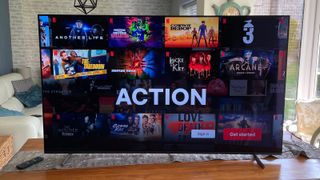
BUY IT IF
✅ You want excellent audio: The A80L delivers impressive built-in audio that does a good job with Dolby Atmos effects.
✅ You want brilliant picture quality: The Sony A80L also delivers a sharp, refined picture with fantastic detail at a mid-range price
DON’T BUY IT IF
❌ You want the brightest OLED screen: Other OLEDs TVs from brands like LG and Samsung offer higher brightness levels than the A80L.
❌ You want all the latest gaming features: The A80L only has two HDMI 2.1 ports and doesn’t support Dolby Vision at 120Hz either.
The Sony A80L is the mid-range OLED TV in Sony’s 2023 lineup that delivers rich, fulsome audio quality. Thanks to its speaker placement and Acoustic Surface+ technology, the A80L’s built in sound is powerful and punchy, feeling fully connected to the to what’s on screen. Because sound is allowed to travel through the screen itself, the audio is direct and room-filling at the same time. Bass levels are not massive despite multiple subwoofers, but this is undoubtedly one of the best TVs for sound on the market at the moment.
Not just packed with an incredible sound system, the Sony A80L offers excellent picture quality. With spectacular sharpness and detail, the A80L provides crisp images with both 4K and upscaled HD movies and TV shows. The color handling on the A80L is top-tier as well, which in our review we said was “mesmerizingly precise”. The A80L does however have lower brightness levels than our top pick OLEDs, including the Samsung S90C at #1 on the list.
The Sony A80L also has good gaming features with 4K 120Hz, VRR and ALLM support. Sadly, it only has two HDMI 2.1 ports, where TVs from LG and Samsung will have it across all four ports and it doesn’t support Dolby Vision gaming at 120Hz either; something that LGs’ mid-range OLEDs have been supporting since 2021. However, it does have ‘Perfect for PlayStation’ features, meaning it has a special HDR mode for the PS5, and custom image presets for different genres of game.
It may be slightly more expensive than other entry-level/mid-range OLEDs, such as the LG C3, but if you’re a Sony fan, you won’t be disappointed by the A80L’s amazing sound quality and brilliant picture.
Read our full Sony A80L review
More TVs to consider
If you’re looking for an elite TV for wall-mounting, the LG G3 is one to strongly consider. Its overall performance is close to the Samsung S95C, and it comes with a special ‘Zero Gap’ wall bracket in the box that means it sits… well, flush to the wall. Very slick, and a great looking TV. However, the S95C edges it out of this list overall, because we love the One Connect box (also a huge bonus if you’re wall-mounting) and it’s a slightly better performer overall. But definitely read our full LG G3 review if you know you’ll wall-mount and you want a high-end TV.
If you’re looking at the Hisense U8K but thinking you’d like something with better gaming features, the Samsung QN85C is a TV to consider. It has four HDMI 2.1 ports instead of two on the Hisense, and Samsung’s Game Bar menu systems are great for tweaking settings just to your liking. It has better sound than the Hisense, too. In general, the Hisense offers better picture bang for your buck, though, and is still good for gaming overall, so it keeps its place on this list more broadly. Here’s our full Samsung QN85C review to read more about this model.
Sony has a couple of TVs that are worth consideration, but have really just been kept out of this list by better-value options. However, Sony’s image processing and built-in audio are both excellent, so they’re a real connoisseur’s choice. The Sony X90L is a superb gaming TV if you have a PS5, because it has some custom features to make the console look its best. And the Sony X95L is a high-end mini-LED TV with very impressive contrast and excellent colours and detail, but it’s not as bright as the competition from Samsung, and is very premium priced. Anyone looking for a bright PS5 gaming TV should read our Sony X90L review, and our Sony X95L review will be of interest to anyone looking for an alternative to Samsung’s high-end LCD TVs.
At the small and super-cheap end, we recently reviewed the Amazon Fire TV 2-Series, which didn’t blow us away, but still offers strong value. It has better sound than a lot of small and cheap TVs, which we really appreciate, and the Amazon Fire TV software is nicer to use than a lot of low-price rivals – but the picture quality was frustrating inconsistent. However, a very cheap TV that you can hear clearly, and makes it easy to find what you want, will definitely be tempting for plenty of people. Here’s our full Amazon Fire TV 2-Series review.
How to choose the best TV for you
How do I choose the best TV for me?
There are tons of things you could consider when buying a new TV, but not everyone needs to get stuck in the technological weeds. Here’s the advice our editors tend to give the (many) people who ask this of them in real life.
First, set your budget and your size. Choose a maximum amount you’re willing to spend, and the size of TV you want, and then narrow your search to only models that fit both of those criteria. You will find that already you’re down to looking at only a handful of options, making it much easier to get a grip on things. If you have quite a high budget, set yourself a minimum budget too to help narrow things – maybe 30% below your maximum budget.
When considering the size of the TV, think where you’ll be installing it; it can make all the difference if you’re using one of the best TV wall mounts to mount your TV, or just placing it on a stand, as the same TV can look different on both these places.
So now you’ll need to make a few further decisions. If you’re looking at the mid-range or premium end of things, do you want an OLED TV or an LED/mini-LED TV? In sizes of 55 inches and up, LED TVs tend to be brighter than OLEDs, and so are great for watching sports or TV during the day in bright rooms. But for movie nights, OLED TVs are the best, thanks to their unrivalled contrast – they just don’t go as bright as LED TVs unless you get the most expensive models.
If you’re buying a mid-range set, you’ll need to decide if you need a 120Hz screen or not. This is great for gamers (especially those with a PS5 or Xbox Series X), and good for movies, because it can show more natural motion. But if you want to save cash, getting a 60Hz TV might be a better idea, because 120Hz TVs always cost more.
And then, spare a thought to sound. Most of today’s thin TVs have weak built-in sound. If you don’t mind buying one of the best soundbars too (or if you already have one), then don’t worry about this. But if you don’t want extra boxes in your setup, then focus on the TVs we’ve recommended where we mention the audio is stronger. Sadly, it tends to be higher-end sets that do this better – but even then, not all are created equal. Sony and Samsung are usually strong for audio, though, so are a good place to start.
What TVs are coming in 2024?
We’ve already heard about a lot of exciting new TVs coming in 2024 from LG, Samsung and more and we’ll be sure to update this guide when we’ve had a chance to test them.
Samsung has lifted the lid on its entire new TV range including the flagship Samsung S95D, which features new anti-glare tech and as well as the Samsung S90D, follow-up to our TV of the year, the Samsung S90C. The S90D introduces two new sizes in 42 and 48-inch (although admittedly not QD-OLED). There’s also the mini-LED Samsung QN90D.
LG has also announced its 2024 lineup including the LG G4, which again promises even higher brightness than the LG G3 and the LG C4, LG’s mid-range OLED that promises over 1,000 nits of peak brightness and having seen it in person, the brightness boost from last year’s LG C3 is there. There’s also the LG M4, its wireless OLED.
Of course, it’s not all about LG and Samsung. TCL announced its 2024 TV lineup, icnluding a 115-inch mini-LED with 20,000 local dimming zones. Hisense also unveiled a 110-inch TV amongst its 2024 mini-LED heavy TV range.
There have been no announcements from Sony just yet as they tend to come later in the year, but as soon as we get news we’ll be sure to update you. As with all these TVs, once we get our hands-on testing we’ll update this guide with our impressions.
Which TV is the best quality?
That depends how you define quality. We define it as the ultimate mix of picture quality, features, design and price – when recommending the TV that’s best for most people at any given price, that’s what we’re looking for. And that’s why the Samsung S90C is at the top of our list – there are TVs that do individual things better, but nothing else does so much stuff so well, for the same kind of price.
The best premium OLED on the market for us is the Samsung S95C, the Samsung S90C’s more premium sibling, but it comes with a bigger price tag and when this is matched up against the S90C, the S90C delivers better value overall.
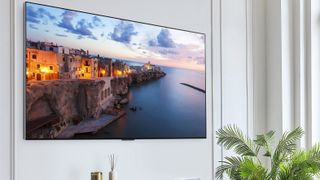
Which brand is best for TVs in 2024?
There’s no one brand that does TVs better than the others, but there are definitely some TV makes that excel in certain areas more than their rivals.
Some of the best brands on our list are Hisense, LG, Samsung, Sony, TCL and Vizio. They all tend to be the top-performing brands at the premium end, though all bring out a wide range of models each year.
The Samsung S90C is at the top of our best TV guide right now with an outstanding picture and although it’s expensive, it’s excellent value for money. With steps into the QD-OLED world, of which the Samsung S90C is one, Samsung has established itself as a real contender for best OLED TVs, with the also impressive Samsung S95C offering incredible picture quality and performance. There’s still also Samsung’s dynamic mini-LEDs on offer that will suit most people with bright environments.
LG also certainly make excellent OLED TVs – in fact, LG Display makes the OLED panels for most other brands. We like that LG offers a wide range of TVs, including different budgets and sizes – the LG C3 goes from 42 inches all the way up to 83-inches. LG’s webOS is one of our favorites, an easy to use operating system that feels intuitive.
Sony is another major player in the TV space. Its screens boast stunning picture quality and build quality. Although, like other brands in this list, there’s a wide range across the board. One interesting difference about Sony is its really pushed its Cognitive XR processor, a processing chip added to its TVs from 2021 that boosts vision and audio performance.
Of course you shouldn’t feel hemmed in by these four brands – Panasonic offers excellent premium TVs with a focus on image quality in particular, and Hisense and TCL offer great value in the mid-range and affordable end of the market.
Which is better OLED or QLED?
This is one of the biggest and more contentious TV tech questions of the moment. Luckily we’ve covered all of the details in our OLED vs QLED guide.
However, if you’re looking for a summary we’d say that QLED is a great option for brightness if you’ll watch in bright, sunlit conditions; whereas OLED TVs offer better viewing angles and superior contrast for gorgeous movie-like images, as long as you can control the lighting.
Is 4K better than OLED?
Luckily, you don’t need to decide whether to go with OLED or 4K – you can have both! 4K refers to the resolution (ie, the number of pixels on the screen), while OLED refers to the panel technology (ie, what the pixels are made from).
So you can have 4K screens that are OLED (almost all of them are, apart from some pricey 8K OLED TVs), and you can have 4K screens that are QLED, mini-LED or other tech.
Is LG better than Samsung?
Both LG and Samsung are excellent TV brands and you can’t really go wrong with either. However, there are some areas where one TV maker could be a better option than the other.
An LG TV tops our best TVs guide, but Samsung is the market leader for sales overall. If you’re looking for the most impressive picture quality out there, regardless of price, nothing currently beats LG’s OLED panels for color and contrast.
But Samsung TV’s are incredibly bright, particularly in more affordable models. We also love Samsung’s lifestyle sets, like The Frame QLED 4K TV (2022), for combining performance with style. And its cheaper TVs are usually excellent value for money.
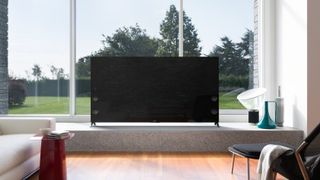
How we test the best TVs
When it comes to reviewing the best TVs, we base our scores on the following criteria that you’ll find in our reviews: picture quality, audio quality, gaming features, smart TV features and ease of use, design, and value for money. We reach these conclusions using both objective measurements and our subjective opinion from viewing the TV. You can read in-depth how we test TVs at TechRadar at that link, or read on for an overview.
Testing picture quality, we start by cycling through the TVs picture presets – Standard, Movie, Sports and so on – to establish where they have strengths and weaknesses, and which is the most accurate. We test these picture modes through several sources including 4K Blu-ray and streaming, HD Blu-ray and streaming, and lower-resolution sources such as DVD and broadcast TV to test a TV’s upscaling effectiveness.
While testing, we’re looking to see how the TV’s processing handles various elements of the pictures. How is motion handled in 24fps movies compared to sports, for example, or how natural the details look when upscaled from lower-quality to higher quality. We’ll test to see whether digital noise reduction processing ruins the look of film grain, and how well a TV handles the digital artefacts and color banding that are common on streaming services.
We’re also looking for how well a movie handles dark tones, especially if it’s an LCD model, and this includes and backlight blooming from light to dark areas, and any unevenness in the backlight.
When it comes to objective measurements, we use specialized equipment, including a test pattern generator to create measurable signals, a colorimeter to read them, and Portrait Display’s Calman Calibration software to record our results.
The first area we’ll usually test is brightness. We’ll measure a TV’s brightness over different sized, white window patterns, such as 10% (for HDR highlights) and 100% or fullscreen brightness. The 10% window tells us the maximum brightness we can realistically expect a set to achieve in real use, while the 100% window tells us how bright it can go in something like sports where brightness is even for a long time, and is important for understanding how well a TV will beat reflections. We do this to test not only how effective a TVs backlight will be, but also to measure against claimed brightness from manufacturers. When we test brightness, we make sure to do it in a light-controlled room to prevent any interference from other light sources which could affect results.
We also test the color reproduction of TVs, in both SDR and HDR, to test their accuracy to the source material, and how much of the maximum possible color gamut they can show. We’ll also test accuracy not only for color but grayscale tones, to see how accurate a TV’s contrast is, looking in particular at just how true its representation of black tones are.
For gaming, we use a Leo Bodnar 4K Input Lag Tester to see what kind of latency is added to games by the TVs processing, and we always test this in the Game Mode equivalent. We’ll test other gaming features, such as 4K 120Hz and Variable Refresh Rate support, using a games console for real resting.
It’s worth noting that although we strive to test every TV in matching conditions and with the same equipment, some of our writers have different setups. We only use writers with equipment that is at the same level of accuracy as ours, and they will run the same tests.
The latest updates to the best TVs buying guide
June 10 2024
Replaced the LG C3 OLED TV as ‘Best for versatility’ with the new LG C4 due to improved brightness and enhanced gaming features.
May 13 2024
Replaced the Samsung S95C as ‘Best premium OLED’ option with the new Samsung S95D.
April 12 2024
Added a new ‘More TVs to consider section’, covering other models not in the list, and explaining why they missed the cut.
March 19 2024
Added benchmark charts for every TV, to make it easy to compare performance.
February 26 2023
Expanded the How we Test section to include a more in-depth breakdown of our testing methods for the TVs in this guide.
November 10 2023
Added author bio and link to TechRadar’s Best Black Friday TV Deals page.
October 12 2023
Added this ‘latest updates’ section to keep readers informed of any changes to this buying guide. Updated several products in this list to reflect our latest reviews, and following price cuts and lack of stock of older TVs.
